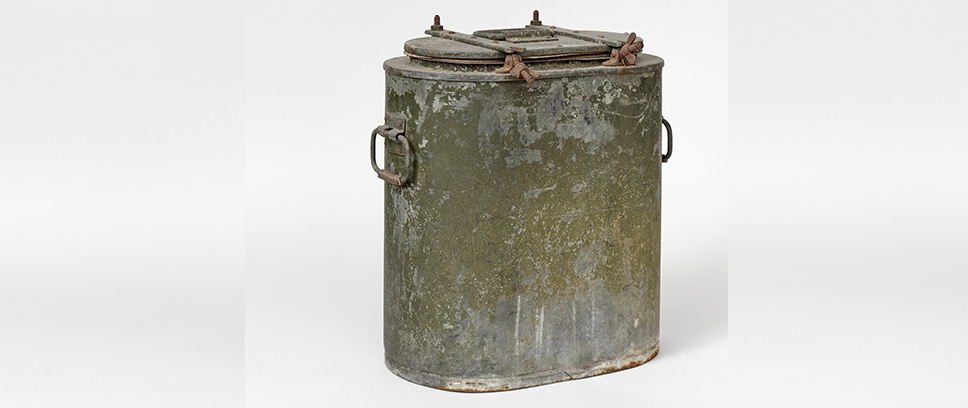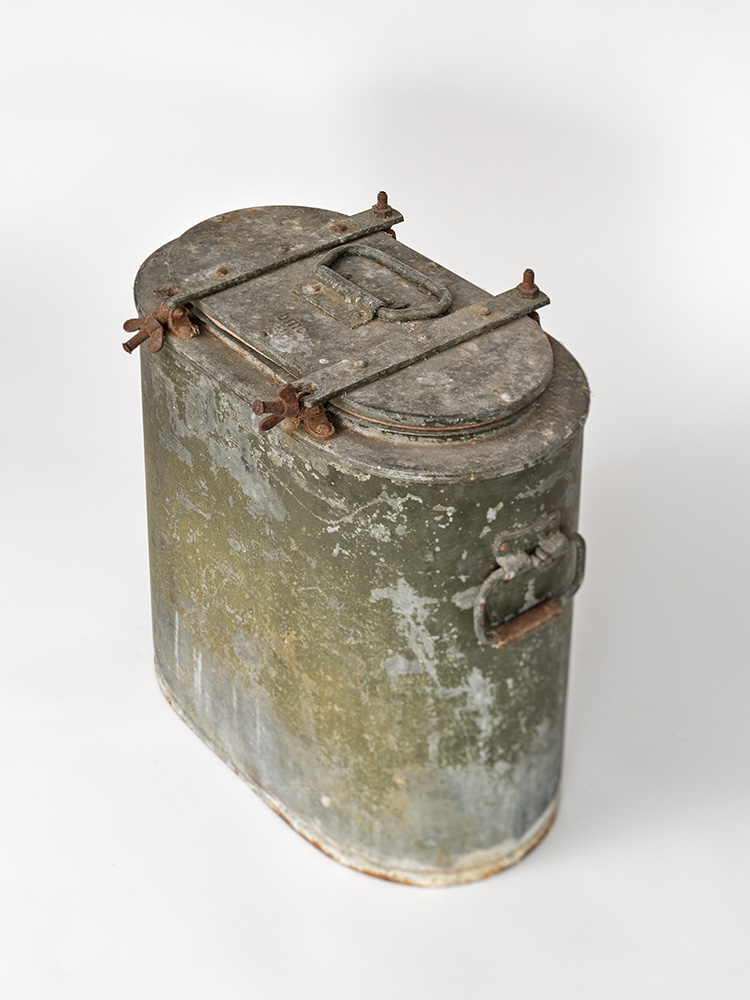
“What’s that for? Wolf Biermann’s diaries in the “soup pail”
Dirk Schreiber | 9. August 2023
Buried beneath a wooden shed in the peaceful little village of Brodowin in Brandenburg in the 1980s slumbered a treasure that many eyes in the GDR would like to have caught a glimpse of – above all the eyes of the Ministry for State Security. For what was hidden below ground were the most intimate memoirs of the perhaps loudest critic of the GDR state: the diaries of Wolf Biermann, buried in an old food container from the time of the German Wehrmacht. Dirk Schreiber, project assistant on the exhibition “Wolf Biermann. A Poet and Songwriter in Germany”, writes about one of the oddest objects in the exhibition.

Since 1954, one of Wolf Biermann’s most persistent habits is to keep a diary. Like an “electrocardiogram of the soul”, Biermann’s diaries are above all chronicles of his daily experience. 1 As such, they contain anecdotes, observations and comments on personal and political events. But above all, they contain names. Names of acquaintances, friends. And it was these names in particular that made the diaries increasingly explosive, especially as Biermann’s confrontation with the SED party leadership became more and more radical. In the hands of the Stasi, the books could have meant serious danger to Biermann’s confederates. The writings gave evidence of their close relationship with Biermann and of the discussions during their numerous encounters.
Shortly before his famous concert in Cologne, which immediately preceded his expulsion from the GDR on 16 November 1976, he expressed his concern: “I’m afraid I will be arrested and that they will steal my many diaries.”2
But Biermann’s friend Reimar Gilsenbach came up with an idea. As an avid environmental activist and dissident, Gilsenbach, born near Wesel am Niederrhein in 1925, had already come into conflict with the GDR leadership. During the Prague Spring in 1968, he had helped Biermann to go into hiding for a short time when Biermann thought he would be arrested due to the tense situation. Now, in autumn 1976, Gilsenbach took in Biermann’s 50 diary volumes in a dramatic “cloak-and-dagger” operation. As a hiding place for the books he chose his property in Brodowin, where the “Brodowiner Talks” were later founded, one of the first discussion forums on environmental protection in the GDR.3
Bild df_mo_0000483_002: Reimar Gilsenbach, 1983 © Deutsche Fotothek / Barbara Morgenstern
As a durable and waterproof hiding place for the diaries Gilsenbach chose a thermos-container from the stocks of the former Wehrmacht.
Thermos-containers of this kind were products of the trench warfare in the First World War. In earlier wars the military planners assumed that they would normally be decided in great battles. With regard to the provisioning of the soldiers, such an agenda had the advantage that they could eat before or after the battle. Furthermore, far into the 19th century there were no central field kitchens in many armies. Every soldier cooked their own meal over a fire or on a cooker. After daylong marches or gruelling battles, that activity cost them time and energy. This was alleviated by the first mobile field kitchens, which were introduced in the Russian and Swiss armies around 1890.4 The task of cooking in the field was now transferred to field cooks and field bakers.
But the realities of stationary warfare from 1914 on required an adjustment to the gastronomic system. The trenches had to be permanently manned. At the same time the field kitchens could not be moved all the way to the front line for security reasons.
So if the soldiers could no longer come to the kitchen, the meals – warm, if possible, in all seasons – had to get to them. The result was a food or meal carrier: a double-walled metal container with cork insulation and a removable vessel that could hold up to 12 litres of food or drink. The lid was hinged and there was a small ladle attached inside. The container could be carried on one’s back like a rucksack by means of two leather straps. Every field kitchen had up to six such containers, which were delivered to the soldiers of the unit that was to be catered for.5 From there the meals were brought to the comrades on the front.
Bild ZD006393: “Food carriers on the way to the front line.” Propaganda postcard from the Second World War. Berlin, Deutsches Historisches Museum: PK 2008/261
The first container of this kind was introduced in the German army towards the end of the First World War. 6 Its design was so practical that the Wehrmacht continued to use it almost unchanged. The Red Army and some other East European forces adopted the design and used it during the time of the Cold War.
It was probably for this reason that Wolf Biermann termed the food box that contained his diaries a “NVA soup pail”, referring to the National People’s Army of the GDR. Gilsenbach’s container was in fact older, as the inscription “bmc 41” impressed on the top of the lid revealed. “41” refers to 1941, the year of the model, and “bmc” to the manufacturer, the enamel works Grässler & Schmidt in Geithain, Saxony. 7
Bild WB-0688 II: The food container in which Reimar Gilsenbach hid Wolf Biermann’s diaries. Photo: Eric Tschernow
During a trip to West Germany in 1988, Gilsenbach visited his friend Biermann in Hamburg and reminded him of the diaries. According to Biermann, he had long since forgotten about the books. He had, however, routinely continued to keep a diary after his expulsion from East Germany. After the fall of the Berlin Wall Gilsenbach dug up the treasure from his garden and returned the books to their author.8 The diary set was once again complete. Biermann later also came to possess the food container as a testimony to the covert action.
Without Gilsenbach’s engagement a large part of Biermann’s diaries would probably not have survived his expulsion to the West. At the latest, the Stasi would have discovered the diaries when they removed Biermann’s belongings from the apartment at Chausseestrasse 131 – with incalculable consequences for Biermann’s friends and family. Today the diaries form the core of Biermann’s preliminary estate now housed in the Berlin State Library. Not only his good friend Gilsenbach had contributed to saving the documents, but also a very profane “soup pail”.
1 Cf.: Roland Berbig: „Wie ein Buchhalter, wie ein Geschichtsschreiber, wie ein Elektrokardiogramm der Seele“ Wolf Biermanns Tagebuch-Werk, in: Wolf Biermann. Ein Lyriker und Liedermacher in Deutschland, Berlin 2003, pp. 184 – 195.
2Wolf Biermann: Warte nicht auf bessre Zeiten!, Berlin 2017, p. 480f.
3Carl Jordan: Ein freiheitlicher Ökologe. Zum Tod von Reimar Gilsenbach, in: Horch und Guck. Historisch-literarische Zeitschrift des Bürgerkomitees „15. Januar“ e.V. (37) 2002, p. 76f.
4Barbara Maiwald: Feldküche und Co. Verpflegung und Ausrüstung im deutschen Heer, Stuttgart 2018, p. 12.
5H.Dv. 476 / 3: Das allgemeine Heeresgerät, Berlin 1937, p. 37.
6Feldküchen-Vorschrift für die große Feldküche, Berlin 1918, p. 10.
7Liste der Fertigungskennzeichen für Waffen, Munition und Gerät, Berlin 1944 (Nachdruck: Nürnberg 1977), p. 130.
8Biermann: Warte nicht auf bessre Zeiten!, p. 482.
|
|
Dirk SchreiberDirk Schreiber worked since 2022 as project assistant on the “Wolf Biermann” exhibition. He studied military history and military sociology in Potsdam and completed a traineeship in the aerospace department of the German Museum of Technology, Berlin. |